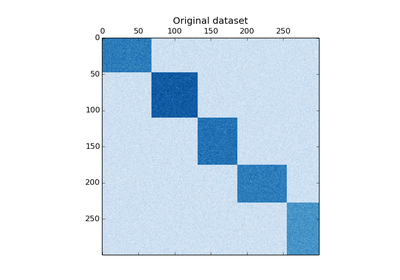sklearn.cluster.bicluster.SpectralCoclustering¶
- class sklearn.cluster.bicluster.SpectralCoclustering(n_clusters=3, svd_method='randomized', n_svd_vecs=None, mini_batch=False, init='k-means++', n_init=10, n_jobs=1, random_state=None)[source]¶
Spectral Co-Clustering algorithm (Dhillon, 2001).
Clusters rows and columns of an array X to solve the relaxed normalized cut of the bipartite graph created from X as follows: the edge between row vertex i and column vertex j has weight X[i, j].
The resulting bicluster structure is block-diagonal, since each row and each column belongs to exactly one bicluster.
Supports sparse matrices, as long as they are nonnegative.
Parameters: n_clusters : integer, optional, default: 3
The number of biclusters to find.
svd_method : string, optional, default: ‘randomized’
Selects the algorithm for finding singular vectors. May be ‘randomized’ or ‘arpack’. If ‘randomized’, use sklearn.utils.extmath.randomized_svd, which may be faster for large matrices. If ‘arpack’, use sklearn.utils.arpack.svds, which is more accurate, but possibly slower in some cases.
n_svd_vecs : int, optional, default: None
Number of vectors to use in calculating the SVD. Corresponds to ncv when svd_method=arpack and n_oversamples when svd_method is ‘randomized`.
mini_batch : bool, optional, default: False
Whether to use mini-batch k-means, which is faster but may get different results.
init : {‘k-means++’, ‘random’ or an ndarray}
Method for initialization of k-means algorithm; defaults to ‘k-means++’.
n_init : int, optional, default: 10
Number of random initializations that are tried with the k-means algorithm.
If mini-batch k-means is used, the best initialization is chosen and the algorithm runs once. Otherwise, the algorithm is run for each initialization and the best solution chosen.
n_jobs : int, optional, default: 1
The number of jobs to use for the computation. This works by breaking down the pairwise matrix into n_jobs even slices and computing them in parallel.
If -1 all CPUs are used. If 1 is given, no parallel computing code is used at all, which is useful for debugging. For n_jobs below -1, (n_cpus + 1 + n_jobs) are used. Thus for n_jobs = -2, all CPUs but one are used.
random_state : int seed, RandomState instance, or None (default)
A pseudo random number generator used by the K-Means initialization.
Attributes: rows_ : array-like, shape (n_row_clusters, n_rows)
Results of the clustering. rows[i, r] is True if cluster i contains row r. Available only after calling fit.
columns_ : array-like, shape (n_column_clusters, n_columns)
Results of the clustering, like rows.
row_labels_ : array-like, shape (n_rows,)
The bicluster label of each row.
column_labels_ : array-like, shape (n_cols,)
The bicluster label of each column.
References
- Dhillon, Inderjit S, 2001. Co-clustering documents and words using bipartite spectral graph partitioning.
Methods
fit(X) Creates a biclustering for X. get_indices(i) Row and column indices of the i’th bicluster. get_params([deep]) Get parameters for this estimator. get_shape(i) Shape of the i’th bicluster. get_submatrix(i, data) Returns the submatrix corresponding to bicluster i. set_params(**params) Set the parameters of this estimator. - __init__(n_clusters=3, svd_method='randomized', n_svd_vecs=None, mini_batch=False, init='k-means++', n_init=10, n_jobs=1, random_state=None)[source]¶
- biclusters_¶
Convenient way to get row and column indicators together.
Returns the rows_ and columns_ members.
- fit(X)[source]¶
Creates a biclustering for X.
Parameters: X : array-like, shape (n_samples, n_features)
- get_indices(i)[source]¶
Row and column indices of the i’th bicluster.
Only works if rows_ and columns_ attributes exist.
Returns: row_ind : np.array, dtype=np.intp
Indices of rows in the dataset that belong to the bicluster.
col_ind : np.array, dtype=np.intp
Indices of columns in the dataset that belong to the bicluster.
- get_params(deep=True)[source]¶
Get parameters for this estimator.
Parameters: deep: boolean, optional :
If True, will return the parameters for this estimator and contained subobjects that are estimators.
Returns: params : mapping of string to any
Parameter names mapped to their values.
- get_shape(i)[source]¶
Shape of the i’th bicluster.
Returns: shape : (int, int)
Number of rows and columns (resp.) in the bicluster.
- get_submatrix(i, data)[source]¶
Returns the submatrix corresponding to bicluster i.
Works with sparse matrices. Only works if rows_ and columns_ attributes exist.
- set_params(**params)[source]¶
Set the parameters of this estimator.
The method works on simple estimators as well as on nested objects (such as pipelines). The former have parameters of the form <component>__<parameter> so that it’s possible to update each component of a nested object.
Returns: self :



